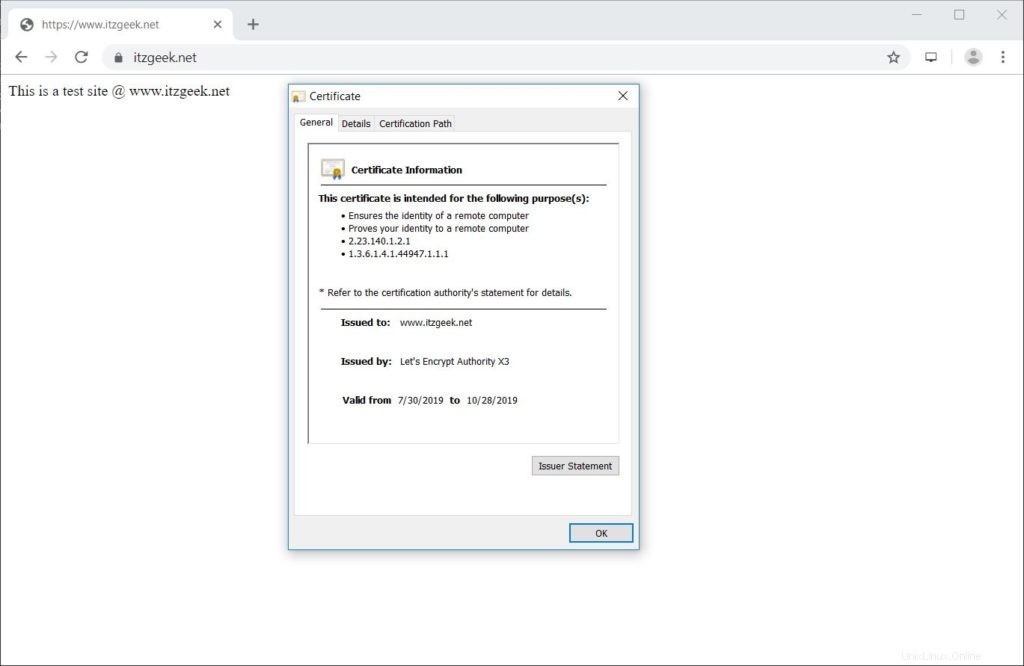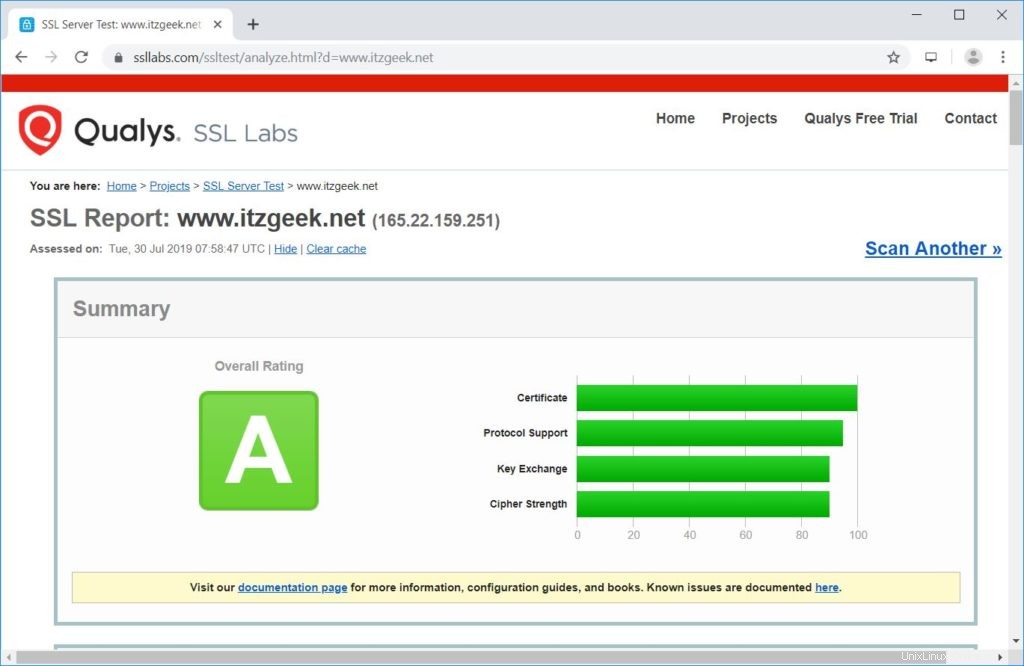Let's Encrypt est une autorité de certification qui fournit des certificats SSL gratuits pour le chiffrement TLS, lancé en avril 2016.
Let's Encrypt ne fournit pas seulement des certificats SSL; il automatise également la création, la validation, la signature, la mise en œuvre et le renouvellement des certificats pour les sites Web sécurisés.
Actuellement, Let's Encrypt prend en charge l'installation automatique des certificats sur Apache, Nginx, Plex et Haproxy.
Prérequis
Je vous recommande de configurer la pile LEMP sur votre système avant de poursuivre.
LIRE : Comment installer la pile LEMP sur Debian 10
LIRE : Comment installer la pile LEMP sur Debian 9
Configurer le certificat SSL Let's Encrypt avec Nginx
Installer Certbot
Pour générer un certificat pour votre domaine, vous devez disposer d'un accès au terminal et du client Certbot ACME. Le client Certbot gère l'émission et l'installation des certificats sans temps d'arrêt.
Certbot est disponible sur le référentiel de base Debian. Vous pouvez donc utiliser les commandes ci-dessous pour l'installer.
sudo apt update sudo apt install -y certbot python-certbot-nginx
Créer un hôte virtuel
Nous allons maintenant créer un hôte virtuel pour le domaine www.itzgeek.net.
Cet hôte virtuel sert la version HTTP de votre domaine.sudo nano /etc/nginx/conf.d/www.itzgeek.net.conf
Utilisez les informations ci-dessous.
server {
server_name www.itzgeek.net;
root /opt/nginx/www.itzgeek.net;
location / {
index index.html index.htm index.php;
}
access_log /var/log/nginx/www.itzgeek.net.access.log;
error_log /var/log/nginx/www.itzgeek.net.error.log;
location ~ \.php$ {
include /etc/nginx/fastcgi_params;
fastcgi_pass 127.0.0.1:9000;
fastcgi_index index.php;
fastcgi_param SCRIPT_FILENAME /opt/nginx/www.itzgeek.net$fastcgi_script_name;
}
}
Créez une racine de document pour contenir les fichiers HTML.
sudo mkdir -p /opt/nginx/www.itzgeek.net
Modifier l'autorisation du répertoire.
sudo chown -R nginx:nginx /opt/nginx/www.itzgeek.net
Placez l'exemple de fichier HTML à la racine du document de votre domaine.
echo "This is a test site @ www.itzgeek.net" | sudo tee /opt/nginx/www.itzgeek.net/index.html
Redémarrez le service Nginx.
sudo systemctl restart nginx
Créer / Mettre à jour l'enregistrement DNS
Accédez à votre outil de gestion DNS ou à votre registraire de domaine et créez un enregistrement A/CNAME pour le domaine. Ex :www.itzgeek.net.

Attendez un moment pour laisser l'enregistrement se propager.
Vérifiez la propagation DNS avec l'utilitaire Nslookup sudo apt install -y dnsutils.

Installer le certificat Let's Encrypt
Utilisez la commande certbot pour créer un certificat Let's Encrypt et configurer Nginx pour utiliser le certificat.
sudo certbot --nginx
Suivez l'invite interactive et installez le certificat.
Saving debug log to /var/log/letsencrypt/letsencrypt.log Plugins selected: Authenticator nginx, Installer nginx Enter email address (used for urgent renewal and security notices) (Enter 'c' to cancel): [email protected] << Enter Email ID - - - - - - - - - - - - - - - - - - - - - - - - - - - - - - - - - - - - - - - - Please read the Terms of Service at https://letsencrypt.org/documents/LE-SA-v1.2-November-15-2017.pdf. You must agree in order to register with the ACME server at https://acme-v02.api.letsencrypt.org/directory - - - - - - - - - - - - - - - - - - - - - - - - - - - - - - - - - - - - - - - - (A)gree/(C)ancel: A << Agree to Terms and Conditions - - - - - - - - - - - - - - - - - - - - - - - - - - - - - - - - - - - - - - - - Would you be willing to share your email address with the Electronic Frontier Foundation, a founding partner of the Let's Encrypt project and the non-profit organization that develops Certbot? We'd like to send you email about our work encrypting the web, EFF news, campaigns, and ways to support digital freedom. - - - - - - - - - - - - - - - - - - - - - - - - - - - - - - - - - - - - - - - - (Y)es/(N)o: Y << Subscriber to Newsletter Which names would you like to activate HTTPS for? - - - - - - - - - - - - - - - - - - - - - - - - - - - - - - - - - - - - - - - - 1: www.itzgeek.net - - - - - - - - - - - - - - - - - - - - - - - - - - - - - - - - - - - - - - - - Select the appropriate numbers separated by commas and/or spaces, or leave input blank to select all options shown (Enter 'c' to cancel): 1 << Choose Site to Install Let's Encrypt Obtaining a new certificate Performing the following challenges: http-01 challenge for www.itzgeek.net Waiting for verification... Cleaning up challenges Deploying Certificate to VirtualHost /etc/nginx/conf.d/www.itzgeek.net.conf Please choose whether or not to redirect HTTP traffic to HTTPS, removing HTTP access. - - - - - - - - - - - - - - - - - - - - - - - - - - - - - - - - - - - - - - - - 1: No redirect - Make no further changes to the webserver configuration. 2: Redirect - Make all requests redirect to secure HTTPS access. Choose this for new sites, or if you're confident your site works on HTTPS. You can undo this change by editing your web server's configuration. - - - - - - - - - - - - - - - - - - - - - - - - - - - - - - - - - - - - - - - - Select the appropriate number [1-2] then [enter] (press 'c' to cancel): 2 << Redirect HTTP to HTTPS Redirecting all traffic on port 80 to ssl in /etc/nginx/conf.d/www.itzgeek.net.conf - - - - - - - - - - - - - - - - - - - - - - - - - - - - - - - - - - - - - - - - Congratulations! You have successfully enabled https://www.itzgeek.net You should test your configuration at: https://www.ssllabs.com/ssltest/analyze.html?d=www.itzgeek.net - - - - - - - - - - - - - - - - - - - - - - - - - - - - - - - - - - - - - - - - IMPORTANT NOTES: - Congratulations! Your certificate and chain have been saved at: /etc/letsencrypt/live/www.itzgeek.net/fullchain.pem Your key file has been saved at: /etc/letsencrypt/live/www.itzgeek.net/privkey.pem Your cert will expire on 2019-10-28. To obtain a new or tweaked version of this certificate in the future, simply run certbot again with the "certonly" option. To non-interactively renew *all* of your certificates, run "certbot renew" - Your account credentials have been saved in your Certbot configuration directory at /etc/letsencrypt. You should make a secure backup of this folder now. This configuration directory will also contain certificates and private keys obtained by Certbot so making regular backups of this folder is ideal. - If you like Certbot, please consider supporting our work by: Donating to ISRG / Let's Encrypt: https://letsencrypt.org/donate Donating to EFF: https://eff.org/donate-le
Redirection des requêtes HTTP non-www vers www HTTPS avec Nginx (facultatif)
Nous allons maintenant configurer le serveur Nginx pour rediriger le trafic provenant du site HTTP non-www vers le site WW HTTPS, c'est-à-dire http://itzgeek.net>> https://www.itzgeek.net .
Ici, nous allons modifier le même fichier de configuration que nous avons créé pour la version HTTP du site.
sudo nano /etc/nginx/conf.d/www.itzgeek.net.conf
Ajoutez les informations ci-dessous à la fin du fichier.
# Redirect NON-WWW HTTP to WWW HTTPS
server {
if ($host = itzgeek.net) {
return 301 https://www.itzgeek.net$request_uri;
}
server_name itzgeek.net;
listen 80;
return 404;
}
Redémarrez le service Nginx.
sudo systemctl restart nginx
Vérifier le certificat Let's Encrypt
Vérifiez le certificat Let's Encrypt en visitant votre site Web.
http://votre-http-site-webOU
https://votre-https-site-webVous devriez obtenir la version HTTPS de votre site maintenant.

Tester le certificat SSL
Testez votre certificat SSL pour tout problème et ses cotes de sécurité en accédant à l'URL ci-dessous.
https://www.ssllabs.com/ssltest/analyze.html?d=www.itzgeek.net
Renouveler le certificat Let's Encrypt
Les certificats Let’s Encrypt ont une validité de 90 jours, et il est fortement conseillé de renouveler vos certificats avant leur expiration. Grâce à l'entrée de planificateur intégrée /etc/cron.d/certbot qui s'exécute deux fois par jour pour renouveler les certificats qui sont sur le point d'expirer.
Mais, je vous recommande d'exécuter une commande ci-dessous pour simuler le renouvellement automatique de votre certificat.
sudo certbot renew --dry-run
Sortie :
Saving debug log to /var/log/letsencrypt/letsencrypt.log - - - - - - - - - - - - - - - - - - - - - - - - - - - - - - - - - - - - - - - - Processing /etc/letsencrypt/renewal/www.itzgeek.net.conf - - - - - - - - - - - - - - - - - - - - - - - - - - - - - - - - - - - - - - - - Cert not due for renewal, but simulating renewal for dry run Plugins selected: Authenticator nginx, Installer nginx Renewing an existing certificate Performing the following challenges: http-01 challenge for www.itzgeek.net Waiting for verification... Cleaning up challenges - - - - - - - - - - - - - - - - - - - - - - - - - - - - - - - - - - - - - - - - new certificate deployed with reload of nginx server; fullchain is /etc/letsencrypt/live/www.itzgeek.net/fullchain.pem - - - - - - - - - - - - - - - - - - - - - - - - - - - - - - - - - - - - - - - - - - - - - - - - - - - - - - - - - - - - - - - - - - - - - - - - - - - - - - - - ** DRY RUN: simulating 'certbot renew' close to cert expiry ** (The test certificates below have not been saved.) Congratulations, all renewals succeeded. The following certs have been renewed: /etc/letsencrypt/live/www.itzgeek.net/fullchain.pem (success) ** DRY RUN: simulating 'certbot renew' close to cert expiry ** (The test certificates above have not been saved.) - - - - - - - - - - - - - - - - - - - - - - - - - - - - - - - - - - - - - - - - IMPORTANT NOTES: - Your account credentials have been saved in your Certbot configuration directory at /etc/letsencrypt. You should make a secure backup of this folder now. This configuration directory will also contain certificates and private keys obtained by Certbot so making regular backups of this folder is ideal.
Si la sortie confirme que le renouvellement fonctionne correctement, le renouvellement automatique se déroulera comme prévu.
Conclusion
C'est tout. J'espère que vous avez appris à configurer le certificat SSL Let's Encrypt avec Nginx sur Debian 10. Partagez vos commentaires dans la section des commentaires.